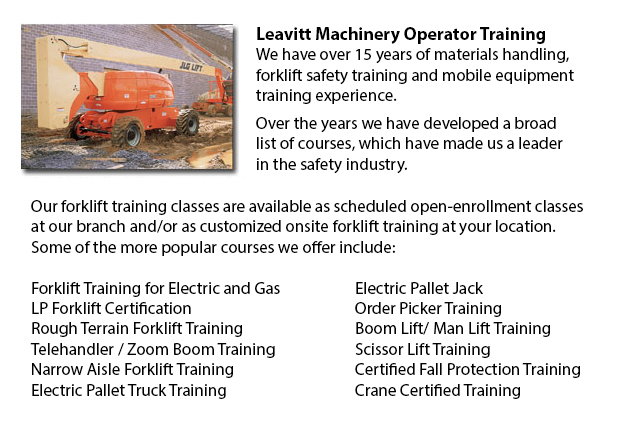
Markham Aerial Boom Lift Training - Aerial Boom Lift Training is required for anybody who operates, supervises or works near boom lifts. This particular type of aerial lift or aerial work platform is used for lifting people, materials and tools in projects requiring a long reach. They are normally utilized to access other above ground job-sites and utility lines. There are different types of aerial booms lifts, like extension boom lifts, cherry pickers and articulating boom lifts. There are two types of boom lift: "telescopic" and "knuckle".
Boom lift training is essential and normally involves the essential equipment, safety and operations problems. Workers are needed whilst working with mobile machinery to know the rules, dangers, and safe work practices. Training course materials offer an introduction to the terminology, applications, skills and concepts needed for employees to gain competence in boom lift operation. The material is aimed at workers, equipment operators and safety experts.
For your company needs, this training is adaptive, cost-effective and educational and would help your workplace become safer and more effective, allowing for higher levels of production. Less workplace incidents happen in workplaces with strict safety policies. All equipment operators should be trained and evaluated. They require knowledge of existing safety standards. They must understand and follow guidelines set forth by their employer and local governing authorities.
It is the employer's responsibility to make certain that employees who are required to utilize boom lifts are trained in their safe use. Each different kind of workplace machine needs its own equipment operator certification. Certifications are available for articulating booms, aerial work platforms, industrial forklift trucks, scissor lifts, et cetera. Employees who are fully trained work more efficiently and effectively than untrained personnel, who need more supervision. Correct training and instruction saves resources in the long run.
Training is the best prevention for the main causes of workplace fatalities: electrocutions, falls and collapses or tip overs. Other than training, the best way to avoid workplace accidents is to maintain and operate aerial work platforms based on the manufacturer's instructions. Allow for the combined weight of the materials, worker and tools when adhering to load limitations. Never override hydraulic, mechanical or electrical safety devices. Workers should be held securely inside the basket with a body harness or restraining belt with a lanyard attached. Do not move lift machinery when workers are on the elevated platform. Workers should take care not to position themselves between the basket rails and beams or joists in order to prevent being crushed. Energized overhead power lines should be at least 10 feet away from the lift machinery. It is recommended that employees always assume wires and power lines might be energized, even if they seem to be insulated or are down. Set the brakes and utilize wheel chocks if working on an incline.
-
Markham Forklift Certification Schools
Markham Forklift Certification Schools - Forklift Certification is mandatory in North America. Hence, forklift training programs are essential both for businesses and for people seeking jobs in industries as forklift operators. Forklift training focu... More -
Telehandler Training in Markham
Telescopic handlers normally called telehandlers for short, are a very popular piece of heavy construction equipment. They are commonly utilized in the construction and agricultural trades. These machines have maximum reaching capability and can get... More -
Markham Zoom Boom Training
Markham Zoom Boom Training - Zoom Boom Training is designed to train operators on variable reach forklifts. The objectives of the training are to impart an understanding of the physics of the machinery, and to outline the operator's tasks. This progr... More -
Markham Heavy Equipment Ticket
Markham Heavy Equipment Ticket - A heavy equipment operator will utilize different construction machinery, depending upon the nature of the task at hand. The large equipment are constructed to carry out specific tasks in the most efficient method for... More -
Markham Scissor Lift Training
Markham Scissor Lift Training - When operating a scissor lift, they must be utilized competently so as to protect the safety of the other employees inside the workplace and to protect the safety of the machine. Competent operators are trained to driv... More -
Markham Manlift Operator Training
Markham Manlift Operator Training - The aerial lift or manlift is a specialized kind of hydraulic platform which is designed to raise a person vertically giving it an alternate name of a vertical personnel lift. These machines are widely used for a m... More -
Markham Heavy Equipment Training
Markham Heavy Equipment Training - The two most common kinds of heavy equipment training are classed into the categories of machinery; equipment that is fashioned with tracks and those with rubber tires. The tracked vehicle are heavy duty equipment s... More -
Markham Forklift Safety Training
Markham Forklift Safety Training - Those wanting work in industries that utilize forklifts should undergo a forklift safety training course before becoming a certified operator of a forklift. There are various ways to go about getting forklift safety... More

Forklift Certification Markham
TOLL FREE: 1-888-254-6157
Markham, Ontario
forkliftcertificationmarkham.com
Email Us
About Us


